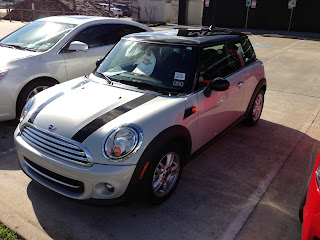In the North American market, we have the Fiat 500, Mini Cooper, Smart ForTwo, and Scion iQ as the main players in the supermini class. These car are small cars with seats in the rear. These cars are designed for getting most fuel economy while still being practical for city driving. In August 2012, General Motors released its supermini car, Daewoo/Chevrolet Matiz, to the United States market. The supermini would be sold in the United States as the Chevrolet Spark. At the 2013 Houston Auto Show, the Spark was available for test drives, but the only Spark available for test drive was pink. However, the Spark does come in other colors. The Chevrolet Spark is a front engine, front wheel drive, five-door hatchback.
On the outside, the Spark is a smaller version of the Sonic, Chevrolet's entry in the subcompact market. The styling is average, nothing really sticks out. Like the Sonic, the rear door handles are integrated nicely behind the windows of the rear doors. The rear door handles do not stick out on doors, like most cars. As far as the interior goes, nothing special. But for a supermini car, I did not feel cramped. I had plenty of leg room and head room behind the wheel. Even when I was sitting in the rear, I still had good leg room and plenty of head room, and I am 5"9. Now for people over 6'0", you might feel cramped. As compromise for the roomy cabin, the is little room for storage in the truck. The rear seats come close to touching the rear hatch.
Powering the Spark is a 1.2L I4 engine, paired with either a five-speed manual, or a four-speed automatic transmission, that produces 84 hp and 83 lb-ft of torque. The Spark goes from 0 to 60 mph in 11.3 seconds and reaches a top speed of 90 mph. On the test drive, it did not feel slow. Over the five days of test driving, other cars felt slower. The ride was smooth. The car responded nicely when I pressed the accelerator and brake pedals. Steering is responsive. The Spark just needs a little bit more power out of the 1.2L engine.
Overall, the Spark is good for what it is. For a supermini, there is plenty of room. I was comfortable inside the Spark, but I wish General Motors had a different color Spark available for test drives instead of pink. Some of the other superminis had noisy rides and when I am trying to talk to a product representative about the car I am driving, it is hard to hear them over the noise from the engine. But, when I was in the Spark, I did not have this problem. It was quiet inside the Spark. I could hear every word from the product specialist. The Spark is ideal for city driving. However, for highway driving look elsewhere. If the Spark came with an engine to produces over 100 hp, then the Spark could be good for highway driving. If you are looking for a car just for city driving and very little highway driving, then test drive the Chevrolet Spark. The base price for the Spark is $12,995, which is a good price for what you get with the Spark. The Spark is one of the least expensive new cars you can buy in the United States.
CarJunkie
Photo was taken by a digital camera.
To see more car related articles, check out http://carjunkie713.blogspot.com/.
Like me on Facebook: https://www.facebook.com/pages/CarJunkies-Car-Review/120292601386720.
Follow me on Twitter @CarJunkie713.






